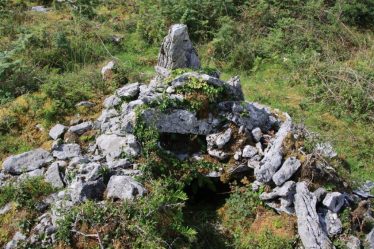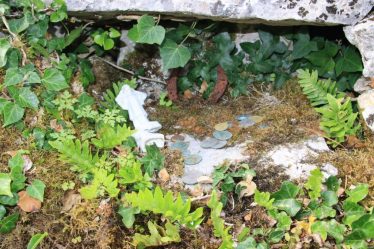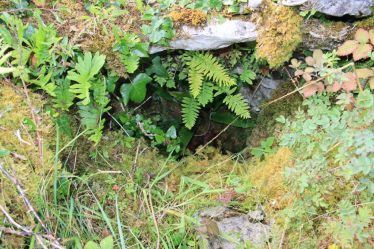Tobaradubh, Tobar an Duibh, Caherfadda



Townland: Caherfadda, Killinaboy
Caherfadda, from the Irish ‘Ceathrú Fada’, which translates as ‘The Long Quarter’ or ‘The Long Townland’.
Description of Holy Well and Landscape Setting
This holy well is in a remote area about 2 kilometres north of the R476 road. The well house is a V-shaped drystone construction, with the two sides fanning out from the well, allowing for wide access. The altar is made of a flagstone inserted in to the dry stone. It is directly above the water and is the focal point for offerings. Scrub is encroaching on the well and if this continues, it will eventually hide the monument.
Saint and Feast Day Associated with Holy Well
There is no pattern day recorded for this holy well. Tobaradubh translates as ‘The Black Well’. Records in the Ordnance Survey Letters, 1839 note:
‘This Well has its name (the Well of the Black) from a black miry sediment which is found at its bottom, and is used by the peasantry for colouring wool, as well as for applying to swellings of the eyes and limbs. I know other places that produce this dye stuff, but they are not held in any sanctified regard, nor do I think this Well has any better claim to the name of Holy.’
The sediment is, in fact, partly decayed organic matter.
The Ordnance Survey ‘Name Books’ refer to the well as ‘Tobar Eidrigg’, which may be a corruption of ‘Tobar Éadaigh’, i.e. The Clothes Well. One source in the Irish Folklore Collection, refers to the well as Saint Joseph’s Well, but this could be in error. (Volume 0614, Page 342).
National Folklore Collection, Schools’ Collection:
‘In Caherfadda there is a holy well called St Joseph’s well. It is a cure for sore eyes. People pay rounds there on Mondays and Thursdays. To be cured one must go three times around the well saying one Our Father and five Hail Marys. One must leave something at the well after them’.
-Told by Thomas Cassidy, Ballycashen; collected by his daughter Nora Cassidy. (IFC 1937/38).
T.J. Westropp, writing in ‘A Folklore Survey of County Clare’ in the early 1900s, recorded:
‘The black mud which gave its name to Toberduff cured sore eyes and swelled limbs’.
Lelia Doolan notes in ‘The Book of the Burren’ that the waters of the well were used for ‘dyeing, sore limbs and swellings.’ A local informant remembered that the waters of the well were used to treat the swollen limbs of horses. The sediment of the well was rubbed on the horses’ limbs. Horseshoes were also left at well. Some are still in evidence at site today, along with broken crockery, religious figurines, coins and pretty stones.
Natural Heritage around the Holy Well
The well is in an area of limestone pavement with Burren speciality flowers blooming in spring and summer. The land is grazed by cattle in autumn and winter.
Heritage Attractions Nearby
Leamaneh Castle, seat of the O’Brien Kingdom in medieval times, is 2 kilometres south-west of the holy well. The villages of Corofin and Kilfenora are not far away. Corofin is about 8 kilometres to the east and Kilfenora is approximately 8 kilometres to the west.
Discover More…
National Folklore Collection, Schools’ Collection 1930s
Doolan, L 2001, in O’Connell, J.W, Broad, R and Korff, A (Eds.), The Book of the Burren, Tír Eolas, Kinvara
Westropp, T.J. 1912, A Folklore Survey of County Clare, edited by Maureen Comber 2000, CLASP Press, Ennis
Record of Monuments and Places Number
RMP CL 016-041




No Comments
Add a comment about this page